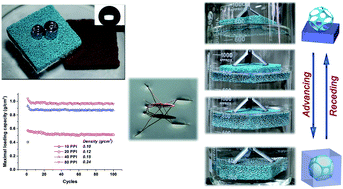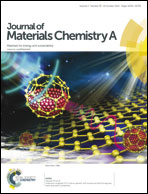Super-floatable multidimensional porous metal foam integrated with a bionic superhydrophobic surface†
Abstract
Creating superhydrophobic surfaces is an important direction for porous materials used in water. We report a novel kind of super-floatable material fabricated from superhydrophobic metal foam as a three-dimensional extension of biologically inspired 1-D and 2-D materials. A simple and widely adaptable method is used to construct a superhydrophobic surface on the metallic skeleton of the copper foam with the pore sizes in the range of 0.5–4.2 mm. The force measurement procedure of the superhydrophobic copper foam in the process of sinking and floating is investigated. These 3D superhydrophobic surfaces are found to enable the metal foam to not only float freely on water, but also to exhibit a high loading capacity and sink resistance. The pore size of the sample is an important parameter reflecting the loading capacity. The smaller the pore size is, the higher the loading capacity. The maximal loading capacity of the sample is about 0.97 g cm−3, nearly equivalent to that generated by an air bubble of the same volume in water. Such porous metal foam mimicking the legs of water striders is expected to extend metal-based floatable materials from 1D metal threads and 2D metal meshes or sheets to 3D metal structures.


 Please wait while we load your content...
Please wait while we load your content...